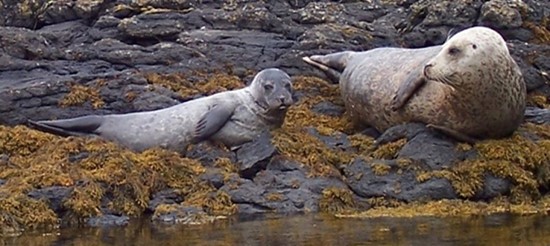Common Seal
- Scientific name: Phoca vitulina
- Also known as: Harbour Seal
- Size: Generally adult males weigh about 85kg and measure about 145cm in length (but have been known to reach 135kg and 185cm). Females weigh about 75kg and are about 135cm long, not much smaller than the males, in fact it is very difficult to tell the males from females.
- International Union for Conservation of Nature status:
– Global: LC (Least Concern)
– Europe: LC (Least Concern) - Distribution: Common around the British Isles and the colder waters of most of Northern Europe. Also common in North American waters with smaller populations elsewhere in the world.
- Feeds on: Mostly fish and squid with all species being taken. May also consume other sources of food which become available such as crabs, lobsters and even marine birds.
- Description: Large powerful fat body with relatively small flippers. Relatively small rounded head with large eyes and nostrils which are close together. Mouth is full of small but sharp teeth. Colour can vary greatly from dark brown/black to light grey. Speckled/spotted colour is present across back and body.
Common seals are found all around the coastline of the British Isles with the highest populations around Scotland and along the eastern coast of England. They are also found throughout the colder waters of Northern Europe. They are non-migratory animals which spend their lives close to the shore, rarely venturing more than a few miles out to sea, but can also be found in rivers.
Common seals live in large groups and can make their home on a variety of different shorelines ranging from sandy beaches and sandbanks to fairly rocky and rugged coasts. However, common seals spend the majority of their time in the water. They are capable of diving to depths of several hundred metres and can remain submerged for over half an hour.
Common seals are unfussy predators which will hunt and eat any type of fish which is available with pelagic (mid-water) species such as mackerel being taken as well as demersal (bottom-dwelling) species such as cod, haddock and plaice and migratory fish such as salmon all being preyed upon. They will also feed on other food sources which present themselves with common seals being known to eat squid, cuttlefish, crabs, lobsters and even marine birds at times. When found in rivers they will also feed on any freshwater fish present.
Females give birth in the summer months after a nine-month gestation period. While the young have an innate ability to swim they are still cared for by their mothers for around two months and rapidly put on weight due to the fatty milk the mother produces. All common seals go through a moulting process after breeding and must spend a longer proportion of time on land during this time.









